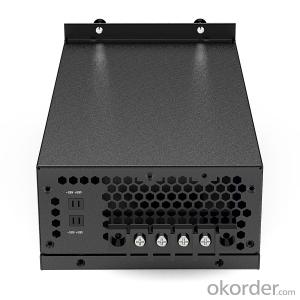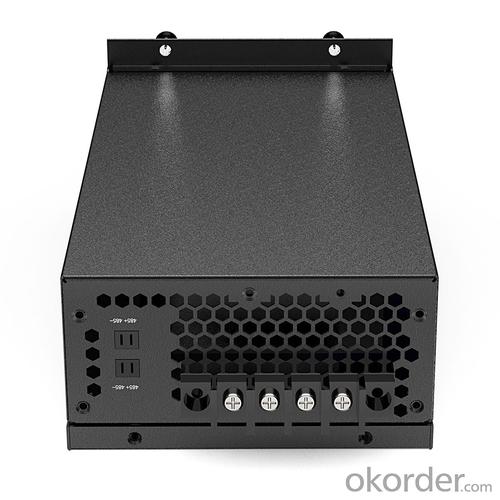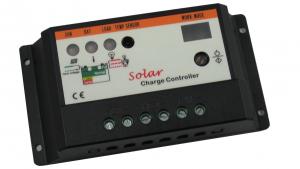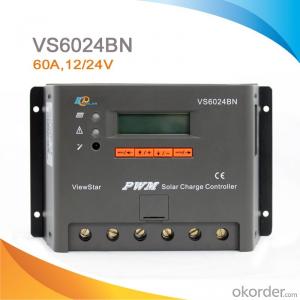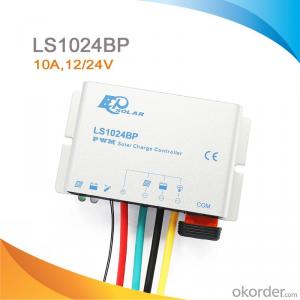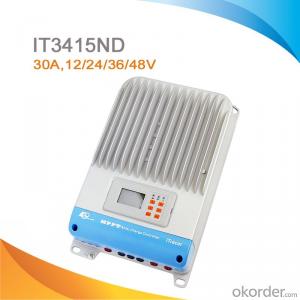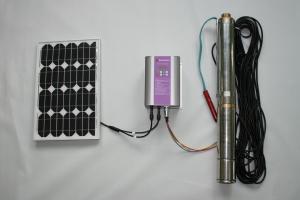MF Series Solar Pool Controllers Suitable for Electric Cabinet
- Loading Port:
- China main port
- Payment Terms:
- TT OR LC
- Min Order Qty:
- 100 pc
- Supply Capability:
- 500 pc/month
OKorder Service Pledge
OKorder Financial Service
You Might Also Like
1. Product Characterist
1.1 Professional design of system reliability overall improvement
Semiconductor device adopt IR、TI、ST、ON and NXP etc. international well-know brands
Industrial grade MCU all digital technology, high capacity of resisiting disturbance, No aging and drifting problem
IP protection grade,no any buttons,improve the waterproof reliability furtherly
1.2 High efficiency MPPT tracking technology
MPPT tracking effiency ≥99.9%, system generation efficiency up to 98%, promote the system efficiency and save the system cost.
1.3 High conversion effiency
Charging conversion efficiency up to 98.8%
1.4 Super tiny static power consumption
No-load current consumption ≤ 35mA(24V system),≤24mA(48Vsystem)
1.5 Inteligient storage battery management
Three phase charging management, MPPT charging, constant voltage charge and float charge, significantly extends the battery life
Base on intelligent temperature compensation charge and discharge management, significantly extend more than 50% battery life
1.6 Flexible parameter setup funtion
RS485 communication,can set parameter flexiblely, various batteries compatibility
1.7 Compete protection funtion
Battery reverse protection
Solar panel reverse proction
Prevent the battery from discharging to solar panel at night
Battery low voltage protection
Battery exits low voltage protection
Output overcurrent protection
2.Product parameter
Item | Content | Model |
Unit
|
M4850 | |||
Battery Parameter | Rated system voltage | Lithium battery program setting, lead acid 24V/48V Auto | - |
Maximum charging current | 50 | A | |
Support maximum number of parallel units | 20 | Pieces | |
Charging voltage range | 20~60 | V | |
MPPT charging voltage @25°C | ≤28.8(24V), ≤57.6(48V) | V | |
Constant voltage average charging pressure @25°C | 28.8(24V), 57.6(48V) | V | |
Constant voltage floating charge @25°C | 27.6(24V), 55.2(48V) | V | |
Temperature compensation coefficient | -4mV/℃/2V | - | |
PV Parameter | PV maximum input voltage | 180 | V |
Maximum solar panel power | 1200(24V) 2400(48V) | W | |
Maximum DC input current | 10*2 | A | |
Starting voltage | 40(24V),70(48V) | V | |
MPPT tracking range | 40≤Vp≤150(24V), 70≤Vp≤150(48V)。 | V | |
System parameter | MPPT efficiency | ≥99.9% | - |
Charge conversion maximum efficiency | 98.8% | - | |
Static power consumption | ≤35(24V)≤24(48V) | mA | |
Conmunication method | RS485 | - | |
Storage/working temperature | -25~60 | ℃ | |
Storage/working humidity | 0~95%(no condensation) | RH | |
altitude | 3000 | m | |
Protection level | IP20 | - | |
Heat dissipation method | Intelligent air cooling | - | |
Certification | CE,ROSH | - | |
Size (mm) | 135*245*83 | mm |
3. Image
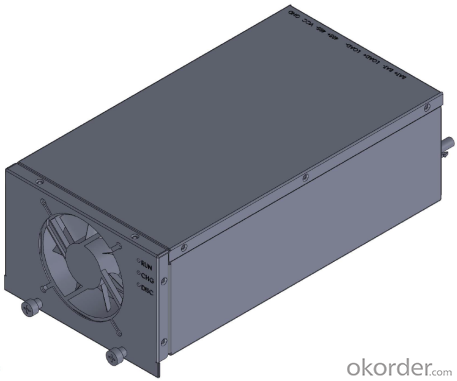
4. FAQ
Q:DO YOU HAVE ANY CERTIFICATION FOR YOUR PRODUCTS?
A:We have ISO9001:2015,CE、RoHS certifications for all of our products.
Q:DO YOU HAVE MOQ FOR PLACE ORDER?
A:Low MOQ,1pe for sample checking is available
- Q: Can a solar controller be used with solar-powered indoor communication systems?
- Solar-powered indoor communication systems can indeed utilize a solar controller. Essentially, a solar controller serves the purpose of regulating the power flow from the solar panels to the batteries. This is done to ensure efficient charging and to prevent overcharging. Despite the fact that indoor communication systems do not directly depend on solar power, they can still reap the benefits of employing solar panels to produce electricity and reduce their reliance on the grid. By incorporating a solar controller into the system, the power generated by the solar panels can be effectively managed, thereby guaranteeing optimal performance and extending the lifespan of the batteries. Consequently, this arrangement enables uninterrupted operation of indoor communication systems, even in the face of power outages or in remote locations where access to grid power may be absent.
- Q: What is the charging current rating of a solar controller?
- The charging current rating of a solar controller refers to the maximum amount of current that it can handle and regulate during the charging process of a solar battery. This rating is typically specified by the manufacturer and can vary depending on the model and capacity of the solar controller.
- Q: What is the role of a solar controller in preventing damage to the solar panels from lightning strikes?
- The role of a solar controller in preventing damage to solar panels from lightning strikes is to divert the excess electrical energy generated by the lightning strike away from the panels. It does this by providing a low-impedance path for the lightning current to follow, effectively bypassing the panels and reducing the risk of damage. Additionally, some solar controllers also offer surge protection features to further safeguard the panels from voltage spikes caused by lightning strikes.
- Q: How does a PWM solar controller regulate the charging process?
- The charging process is regulated by a PWM solar controller, which utilizes a technique called Pulse Width Modulation (PWM) to control the energy flow from the solar panels to the battery. The controller constantly monitors the battery voltage to determine its level of charge. When the battery is low, the controller permits a maximum flow of current from the solar panels to the battery. As the battery voltage increases and reaches a specific threshold, the controller begins to decrease the current flow to avoid overcharging. The PWM technique operates by rapidly switching the solar panel's output on and off. The duration of these cycles is controlled in such a way that the average voltage supplied to the battery matches its requirements. By adjusting the duty cycle of the switching, the controller is able to regulate the charging current. During the on cycle, the solar panel transfers energy to the battery. When the battery voltage reaches the desired level, the controller interrupts the current flow to the battery during the off cycle. This process is repeated continuously to maintain the battery at the optimal charging level. One advantage of using a PWM solar controller is its ability to facilitate a more efficient charging process compared to traditional controllers. It allows for a higher charging current during the initial stages when the battery is deeply discharged, resulting in a faster charging time. As the battery voltage increases, the controller gradually reduces the charging current to prevent overcharging and extend the battery's lifespan. In conclusion, a PWM solar controller regulates the charging process by controlling the duration of the on and off cycles of the solar panel's output. This technique ensures efficient charging and prevents overcharging, maximizing the battery's performance and lifespan.
- Q: Can a solar controller be used with solar trackers?
- Solar trackers can indeed be used in conjunction with solar controllers. The primary purpose of a solar controller is to regulate and optimize the battery charging process within a solar power system. It achieves this by monitoring the voltage and current generated by the solar panels, ensuring efficient and safe charging of the batteries. In contrast, solar trackers are devices that track the sun's movement throughout the day, continuously aligning the solar panels with its position. This maximizes the solar energy output by constantly optimizing the orientation of the panels. Motors or actuators are employed to adjust the panel's position accordingly. Despite their distinct functions, solar controllers and solar trackers can be utilized together in a solar power system. The solar controller will be connected to both the solar panels and batteries, managing the charging process. Simultaneously, the solar tracker will continuously adjust the panel's position to capture the maximum amount of sunlight. By combining these technologies, the solar power system can reap the benefits of increased energy generation and enhanced battery charging efficiency. Consequently, this leads to an overall improvement in system performance and energy output.
- Q: What is the difference between a PWM solar controller and an MPPT solar controller?
- A PWM (Pulse Width Modulation) solar controller and an MPPT (Maximum Power Point Tracking) solar controller are both used in solar power systems to regulate the charging of batteries. The main difference between the two is in their charging efficiency and performance. A PWM solar controller works by rapidly switching the solar panel's output on and off to maintain a steady voltage for charging the battery. However, this method can result in energy loss and lower charging efficiency, especially in situations where the solar panel voltage is much higher than the battery voltage. On the other hand, an MPPT solar controller is designed to optimize the power output of the solar panel by dynamically adjusting the voltage and current to find the maximum power point. This allows the MPPT controller to efficiently convert and deliver more power to the battery, resulting in higher charging efficiency and better utilization of available solar energy. In summary, an MPPT solar controller is generally more advanced and efficient than a PWM solar controller, making it a preferred choice for maximizing the charging efficiency and performance of solar power systems.
- Q: Can a solar controller be used with a solar panel cleaning system?
- Yes, a solar controller can be used with a solar panel cleaning system. The solar controller helps regulate the voltage and current flow from the solar panels to the cleaning system, ensuring efficient and safe operation.
- Q: Can a solar controller be used with solar-powered indoor research facilities?
- Yes, a solar controller can be used with solar-powered indoor research facilities. A solar controller regulates and optimizes the charging and discharging of batteries in a solar power system, ensuring efficient utilization of solar energy. In indoor research facilities that are solar-powered, a solar controller plays a crucial role in managing the power generated by solar panels and ensuring a stable and reliable power supply for various research equipment and systems.
- Q: Can a solar controller be used in a hybrid solar power system?
- Yes, a solar controller can be used in a hybrid solar power system. A solar controller, also known as a charge controller, is an essential component in any solar power system, including hybrid systems. Its main function is to regulate the flow of electricity between the solar panels and the batteries. In a hybrid solar power system, the solar panels are not the sole source of power generation. They are combined with other energy sources, such as a backup generator or grid power. The solar controller plays a crucial role in managing the charging and discharging of the batteries, regardless of the energy source. The solar controller ensures that the batteries are charged optimally and prevents overcharging or deep discharging, which can damage the batteries. It also helps maintain a stable voltage and current output from the solar panels, which is essential for the efficient operation of the hybrid system. Furthermore, a solar controller can incorporate advanced features and technologies, such as Maximum Power Point Tracking (MPPT) or Pulse Width Modulation (PWM), to maximize the energy harvest from the solar panels. These features are beneficial in both standalone solar systems and hybrid systems. In conclusion, a solar controller is a vital component in a hybrid solar power system, as it regulates the flow of electricity and ensures the optimal charging and discharging of the batteries, regardless of the energy source being used.
- Q: Can a solar controller be used with solar panels that are connected to a solar cooling system?
- Yes, a solar controller can be used with solar panels that are connected to a solar cooling system. A solar controller is an essential component of any solar power system, including solar cooling systems. It regulates the flow of electricity from the solar panels to the cooling system, ensuring that the panels are operating at their optimal efficiency and that the cooling system is receiving the right amount of power. The solar controller helps manage the charging and discharging of the batteries in the system, preventing overcharging or excessive discharge, which can lead to damage. It also monitors the voltage and current output from the solar panels, ensuring that the cooling system receives a steady and consistent power supply. In a solar cooling system, the solar panels collect sunlight and convert it into electricity, which is then used to power the cooling system. The solar controller plays a vital role in controlling the power flow and ensuring that the cooling system operates effectively. By utilizing a solar controller, the solar cooling system can maximize its energy efficiency, reduce energy consumption, and increase overall system performance. It also helps to extend the lifespan of the solar panels and batteries by preventing any potential damage caused by irregular power flow. In conclusion, a solar controller is a crucial component in a solar cooling system that allows for the efficient and effective use of solar panels to power the cooling system.
Send your message to us
MF Series Solar Pool Controllers Suitable for Electric Cabinet
- Loading Port:
- China main port
- Payment Terms:
- TT OR LC
- Min Order Qty:
- 100 pc
- Supply Capability:
- 500 pc/month
OKorder Service Pledge
OKorder Financial Service
Similar products
Hot products
Hot Searches
Related keywords
